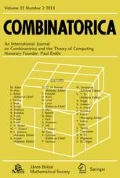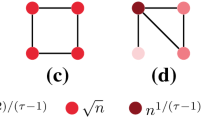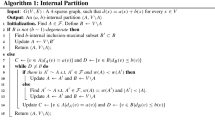Abstract
We introduce a general class of algorithms and analyse their application to regular graphs of large girth. In particular, we can transfer several results proved for random regular graphs into (deterministic) results about all regular graphs with sufficiently large girth. This reverses the usual direction, which is from the deterministic setting to the random one. In particular, this approach enables, for the first time, the achievement of results equivalent to those obtained on random regular graphs by a powerful class of algorithms which contain prioritised actions. As a result, we obtain new upper or lower bounds on the size of maximum independent sets, minimum dominating sets, maximum k-independent sets, minimum k-dominating sets and maximum k-separated matchings in r-regular graphs with large girth.
Similar content being viewed by others
References
M. Beis, W. Duckworth and M. Zito: Packing vertices and edges in random regular graphs, Random Structures & Algorithms 32 (2008), 20–37.
E. A. Bender and E. R. Canfield: The asymptotic number of labeled graphs with given degree sequences, J. Combinatorial Theory Ser. A 24 (1978), 296–307.
B. Bollobás: Random graphs, Academic Press, London, 1985.
E. Csóka, B. Gerencsér, V. Harangi and B. Virág: Invariant Gaussian processes and independent sets on regular graphs of large girth, Random Structures and Algorithms 47 (2015), 284–303.
W. Duckworth and B. Mans: Randomized greedy algorithms for finding small k-dominating sets of random regular graphs, Random Structures and Algorithms 27 (2005), 401–412.
W. Duckworth and N. C. Wormald: On the independent domination number of random regular graphs, Combinatorics, Probability and Computing 15 (2006), 513–522.
W. Duckworth and M. Zito: Large 2-independent sets of regular graphs, Electronic Notes in Theoretical Computer Science 78 (2003), 1–13.
W. Duckworth and M. Zito: Large independent sets in random regular graphs, Theoretical Computer Science 410 (2009), 5236–5243.
P. Erdős: Graph theory and probability, Canadian Journal of Mathematics 11 (1959), 34–38.
D. Gamarnik and D. A. Goldberg: Randomized greedy algorithms for independent sets and matchings in regular graphs: exact results and finite girth corrections, Combin. Probab. Comput. 19 (2010), 61–85.
D. Gamarnik and M. Sudan: Limits of local algorithms over sparse random graphs, https://doi.org/arxiv.org/abs/1304.1831. Proceedings of the 5th conference on Innovations in theoretical computer science (2014), 369–376.
H. Hatami, L. Lovász and B. Szegedy: Limits of locally-globally convergent graph sequences, Geom. Funct. Anal. 24 (2014), 269–296.
G. Hopkins and W. Staton, Girth and independence ratio, Canadian Mathematical Bulletin 25 (1982), 179–186.
C. Hoppen: Properties of graphs with large girth, Doctoral thesis, University of Waterloo, 2008.
C. Hoppen and N. Wormald: Local algorithms, regular graphs of large girth, and random regular graphs, https://doi.org/arxiv.org/abs/1308.0266v2.
C. Hoppen and N. Wormald: Properties of regular graphs with large girth via local algorithms Journal of Combinatorial Theory, Series B 121 (2016), 367–397.
F. Kardoš, D. Král and J. Volec: Fractional colorings of cubic graphs with large girth, SIAM J. Discrete Math. 25 (2011), 1454–1476.
F. Kardoš, D. Král and J. Volec: Maximum edge-cuts in cubic graphs with large girth and in random cubic graphs, Random Structures & Algorithms 41 (2012), 506–520.
K. Kawarabayashi, M. D. Plummer and A. Saito: Domination in a graph with a 2 factor, J. Graph Theory 52 (2006), 1–6.
D. Král, P. Škoda and J. Volec: Domination number of cubic graphs with large girth, J. Graph Theory 69 (2012), 131–142.
J. Lauer and N. Wormald: Large independent sets in random graphs with large girth, Journal of Combinatorial Theory, Series B 97 (2007), 999–1009.
L. Lovász: Large networks and graph limits, American Mathematical Society Colloquium Publications, 60, American Mathematical Society, Providence (2012).
B. D. McKay: Independent sets in regular graphs of high girth, Ars Combinatoria 23A (1987), 179–185.
M. Rahman and B. Virág: Local algorithms for independent sets are half-optimal, to appear in Annals of Probability, https://doi.org/arxiv.org/abs/1402.0485.
B. Reed: Paths, stars and the number three, Combin. Probab. Comput. 5 (1996), 277–295.
J. B. Shearer: A note on the independence number of triangle-free graphs, II, Journal of Combinatorial Theory, Series B 53 (1991), 300–307.
N. C. Wormald: Differential equations for random processes and random graphs, Annals of Applied Probability 5 (1995), 1217–1235.
N. C. Wormald: The differential equation method for random graph processes and greedy algorithms, in: Lectures on Approximation and Randomized Algorithms, M. Karoński and H.J. Prömel (eds), 73–155, PWN, Warsaw, 1999.
N. C. Wormald: Models of random regular graphs, Surveys in Combinatorics, 1999, London Mathematical Society Lecture Note Series 267 (J.D. Lamb and D.A. Preece, eds), Cambridge University Press, Cambridge, 239–298, 1999.
N. C. Wormald: Analysis of greedy algorithms on graphs with bounded degrees, Discrete Mathematics 273 (2003), 235–260.
N.C. Wormald: Random graphs and asymptotics, Section 8.2 in Handbook of Graph Theory (J. L. Gross and J. Yellen eds), 817–836, CRC, Boca Raton, 2004.
M. Zito: Greedy algorithms for minimisation problems in random regular graphs, Lecture Notes in Computer Science 2161 524–536, Springer-Verlag, 2001.
Author information
Authors and Affiliations
Corresponding author
Additional information
Supported by FAPERGS (Proc. 2233-2551/14-0), CNPq (Proc. 448754/2014-2 and 308539/2015-0) and FAPESP (Proc. 2013/03447-6).
Research supported by the Canada Research Chairs Program, NSERC and the Australian Laureate Fellowship program of the ARC.
Rights and permissions
About this article
Cite this article
Hoppen, C., Wormald, N. Local Algorithms, Regular Graphs of Large Girth, and Random Regular Graphs. Combinatorica 38, 619–664 (2018). https://doi.org/10.1007/s00493-016-3236-x
Received:
Revised:
Published:
Issue Date:
DOI: https://doi.org/10.1007/s00493-016-3236-x




